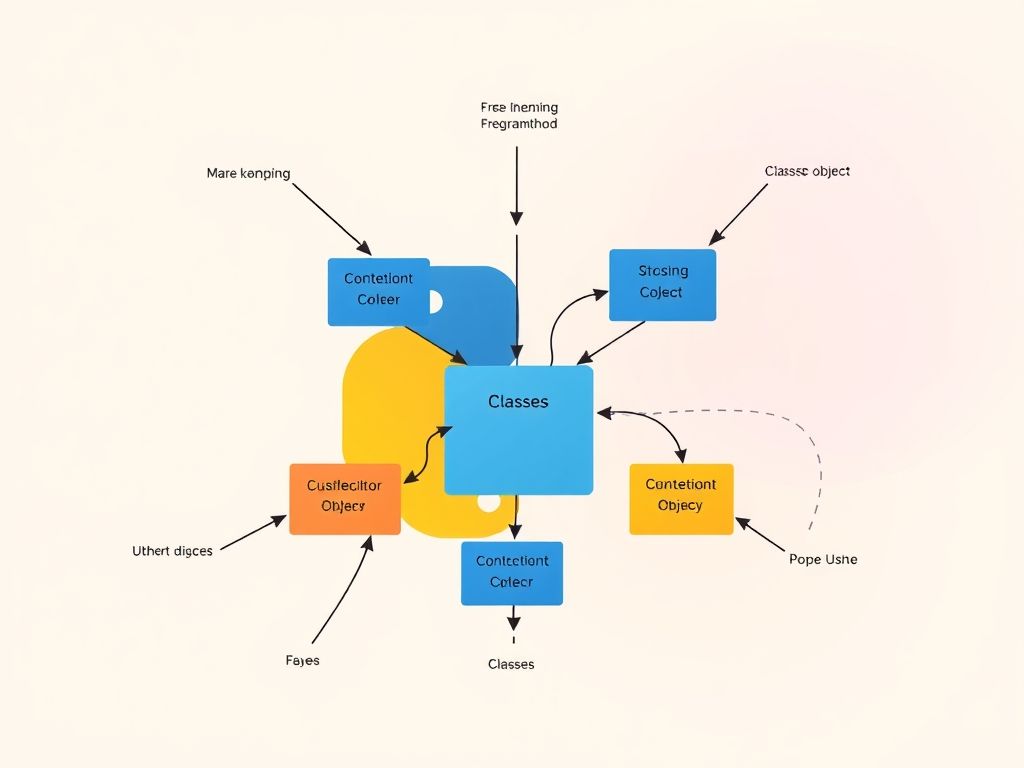Object-Oriented Programming (OOP) is a powerful paradigm in Python that allows you to structure your code in a more organized and reusable way. This guide will walk you through the core principles of OOP in Python, providing practical examples and tips for effective coding. Learn how to leverage OOP to build robust and scalable applications.
Chapter Title: Understanding OOP Concepts
Object-Oriented Programming (OOP) is a programming paradigm centered around “objects,” which contain both data (attributes) and code (methods) that operate on that data. Understanding the core concepts of OOP is crucial for effective **Tip lập trình Python** and writing clean, maintainable, and reusable code. Let’s delve into these fundamental concepts.
Classes
At the heart of OOP lies the concept of a class. A class is essentially a blueprint or a template for creating objects. It defines the attributes (data) and methods (behavior) that objects of that class will possess. Think of it like a cookie cutter; the cookie cutter (class) defines the shape of the cookie, and each cookie made using that cutter is an object.
In Python, you define a class using the `class` keyword:
“`python
class Dog:
pass # We’ll add more later
“`
This simple code creates an empty class named `Dog`. The `pass` statement is a placeholder, indicating that the class doesn’t contain any attributes or methods yet.
Objects
An object is an instance of a class. It’s a concrete realization of the blueprint defined by the class. Using our cookie analogy, an object is one of the cookies created using the cookie cutter. Each object has its own unique set of data, even though they all share the same structure defined by the class.
To create an object from a class in Python, you call the class like a function:
“`python
my_dog = Dog()
“`
Here, `my_dog` is an object of the `Dog` class. It’s a specific instance of a dog.
Attributes
Attributes are variables that hold data about an object. They represent the characteristics or properties of an object. For example, a `Dog` object might have attributes like `name`, `breed`, and `age`.
You define attributes within a class, typically inside the `__init__` method, which is a special method called the constructor. The constructor is automatically called when you create a new object of the class.
“`python
class Dog:
def __init__(self, name, breed, age):
self.name = name
self.breed = breed
self.age = age
“`
In this example, the `__init__` method takes three arguments: `name`, `breed`, and `age`. The `self` parameter refers to the object itself. Inside the `__init__` method, we assign the values of these arguments to the object’s attributes using the `self.attribute_name = value` syntax.
Now, when you create a `Dog` object, you need to provide values for these attributes:
“`python
my_dog = Dog(“Buddy”, “Golden Retriever”, 3)
print(my_dog.name) # Output: Buddy
print(my_dog.breed) # Output: Golden Retriever
print(my_dog.age) # Output: 3
“`
Methods
Methods are functions that define the behavior of an object. They are actions that an object can perform. For example, a `Dog` object might have methods like `bark()`, `fetch()`, and `eat()`.
You define methods within a class, just like attributes. The first parameter of a method is always `self`, which refers to the object itself.
“`python
class Dog:
def __init__(self, name, breed, age):
self.name = name
self.breed = breed
self.age = age
def bark(self):
return “Woof!”
def fetch(self, item):
return f”{self.name} is fetching the {item}!”
“`
To call a method on an object, you use the dot notation:
“`python
my_dog = Dog(“Buddy”, “Golden Retriever”, 3)
print(my_dog.bark()) # Output: Woof!
print(my_dog.fetch(“ball”)) # Output: Buddy is fetching the ball!
“`
Understanding these four core concepts – classes, objects, attributes, and methods – is fundamental to grasping **Lập trình hướng đối tượng**, or **OOP**. These concepts enable you to structure your code in a modular, reusable, and organized manner. Mastering **OOP** principles will significantly enhance your abilities in **Tip lập trình Python** and allow you to create more complex and sophisticated applications.
*These basic building blocks are the foundation upon which more advanced OOP principles are built.*
The next chapter, “Implementing OOP in Python Projects,” will demonstrate how to apply these OOP principles to create reusable code and solve practical problems, including examples of common Python libraries and frameworks that utilize OOP.
Chapter Title: Implementing OOP in Python Projects
Building upon our understanding of OOP concepts – classes, objects, attributes, and methods – from the previous chapter, this section delves into the practical application of Object-Oriented Programming (OOP) in real-world Python projects. We’ll demonstrate how to leverage OOP principles to create reusable, maintainable, and scalable code. This is crucial for mastering **Tip lập trình Python** and becoming a proficient Python developer.
Let’s consider a scenario: developing a simple e-commerce application. Instead of writing procedural code, we can use OOP to model the core components of the application.
First, we can create a `Product` class:
“`html
class Product:
def __init__(self, name, price, description):
self.name = name
self.price = price
self.description = description
def display_details(self):
print(f”Name: {self.name}, Price: {self.price}, Description: {self.description}”)
“`
Here, `Product` is a class, and `name`, `price`, and `description` are its attributes. `display_details` is a method that allows us to view the product’s information. This simple example illustrates the basic structure of a class in Python.
Now, let’s create objects from this class:
“`html
product1 = Product(“Laptop”, 1200, “High-performance laptop”)
product2 = Product(“Mouse”, 25, “Ergonomic wireless mouse”)
product1.display_details()
product2.display_details()
“`
`product1` and `product2` are objects, or instances, of the `Product` class. Each object has its own set of attribute values. This demonstrates the power of **Lập trình hướng đối tượng** (Object-Oriented Programming) to represent real-world entities in code.
Next, we can create a `ShoppingCart` class:
“`html
class ShoppingCart:
def __init__(self):
self.items = []
def add_item(self, product, quantity):
self.items.append({“product”: product, “quantity”: quantity})
def calculate_total(self):
total = 0
for item in self.items:
total += item[“product”].price * item[“quantity”]
return total
def display_cart(self):
for item in self.items:
print(f”{item[‘product’].name}: {item[‘quantity’]}”)
print(f”Total: {self.calculate_total()}”)
“`
The `ShoppingCart` class manages a list of products and their quantities. It includes methods to add items, calculate the total price, and display the cart contents. This encapsulates the logic related to managing the shopping cart within a single class. This is a practical application of **OOP**.
“`html
cart = ShoppingCart()
cart.add_item(product1, 1)
cart.add_item(product2, 2)
cart.display_cart()
“`
This code creates a `ShoppingCart` object, adds the previously created `Product` objects to it, and then displays the cart.
Many popular Python libraries and frameworks heavily rely on OOP principles. For example:
- Django and Flask (web frameworks): Utilize classes to define models (data structures), views (request handlers), and forms.
- NumPy and Pandas (data science libraries): Employ classes to create array and DataFrame objects, providing powerful data manipulation capabilities.
- Tkinter and PyQt (GUI libraries): Use classes to define widgets (buttons, labels, text boxes) and manage user interfaces.
*Understanding how these libraries use OOP is crucial for effective Python development.* By understanding the underlying **OOP** principles, you can better utilize these tools and extend their functionality.
By using OOP, we can create modular, reusable, and maintainable code. Each class represents a specific concept, and its methods encapsulate the logic related to that concept. This makes the code easier to understand, modify, and extend. Furthermore, OOP promotes code reuse, reducing redundancy and improving efficiency.
This chapter has demonstrated how to apply OOP principles to solve a practical problem. By creating classes, objects, and methods, we can model real-world entities and their interactions in code. This approach leads to more organized, maintainable, and scalable applications, a key aspect of effective **Tip lập trình Python**. In the next chapter, we will explore advanced OOP techniques, such as inheritance, polymorphism, and abstraction, which further enhance the power and flexibility of OOP in Python. These techniques are vital for building more complex and robust applications.
Chapter Title: Advanced OOP Techniques
Building upon the foundation of implementing **OOP** in Python projects, as discussed in the previous chapter, we now delve into more advanced techniques that truly unlock the power and flexibility of object-oriented programming. Understanding these concepts is crucial for creating complex, maintainable, and scalable applications. We’ll explore inheritance, polymorphism, and abstraction, and also briefly compare **OOP** with other programming paradigms.
Inheritance: Building Upon Existing Classes
Inheritance is a fundamental **OOP** concept that allows you to create new classes (derived classes or subclasses) based on existing classes (base classes or superclasses). This promotes code reuse and establishes a hierarchical relationship between classes. The derived class inherits attributes and methods from the base class, and can also add new attributes, methods, or override existing ones to customize its behavior.
For example, consider a `Vehicle` class with attributes like `speed` and `color`, and methods like `accelerate()` and `brake()`. You could create `Car` and `Bike` classes that inherit from `Vehicle`. These derived classes would automatically have the `speed`, `color`, `accelerate()`, and `brake()` attributes and methods. The `Car` class might add a `num_doors` attribute, while the `Bike` class might add a `has_basket` attribute. Both could override the `accelerate()` method to reflect the different acceleration characteristics of a car and a bike. This illustrates a core principle of **Tip lập trình Python**: leveraging existing code to avoid redundancy.
Polymorphism: Many Forms, One Interface
Polymorphism, meaning “many forms,” allows objects of different classes to respond to the same method call in their own specific ways. This is achieved through method overriding and interfaces (or abstract base classes in Python). Polymorphism allows you to write code that can work with objects of different types without needing to know their specific class.
Consider the `accelerate()` method again. Both the `Car` and `Bike` classes inherit this method from the `Vehicle` class, but they implement it differently. When you call `accelerate()` on a `Car` object, it accelerates like a car; when you call it on a `Bike` object, it accelerates like a bike. This is polymorphism in action. This capability is invaluable in **Lập trình hướng đối tượng**, allowing for flexible and adaptable code.
Abstraction: Hiding Complexity
Abstraction involves hiding the complex implementation details of a class and exposing only the essential information to the user. This simplifies the use of the class and reduces the risk of errors. In Python, abstraction can be achieved through abstract base classes (ABCs) and interfaces. An abstract base class defines a set of methods that must be implemented by any concrete (non-abstract) subclass.
For example, you might define an abstract base class called `Shape` with an abstract method called `area()`. Concrete subclasses like `Circle` and `Rectangle` would then be required to implement the `area()` method, providing their own specific calculations for the area of the shape. This ensures that all shapes have a way to calculate their area, while hiding the specific implementation details from the user. Abstraction promotes modularity and makes code easier to understand and maintain.
OOP vs. Other Programming Paradigms
While **OOP** offers numerous advantages, it’s important to understand how it compares to other programming paradigms, such as procedural programming and functional programming. Procedural programming focuses on writing a sequence of instructions to perform a task, while functional programming emphasizes the use of pure functions and immutable data.
**OOP** excels at modeling real-world entities and their interactions, making it well-suited for complex applications with many interacting components. Procedural programming can be simpler for small, straightforward tasks, while functional programming can be beneficial for tasks that involve parallel processing and data transformations. The choice of paradigm depends on the specific requirements of the project. Understanding the strengths and weaknesses of each paradigm is essential for effective software development.
In conclusion, mastering advanced **OOP** techniques like inheritance, polymorphism, and abstraction is crucial for building robust, maintainable, and scalable Python applications. By understanding these concepts and how they compare to other programming paradigms, you can write more effective and efficient code, truly unlocking the power of **Lập trình hướng đối tượng** in Python.
Conclusions
Mastering OOP principles empowers you to write cleaner, more organized, and maintainable Python code. By understanding these concepts, you’ll be well-equipped to tackle complex programming tasks and build robust applications.











